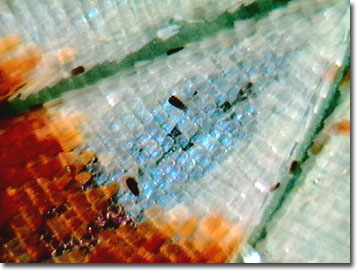Butterfly Wing Scale Digital Image Gallery
Common Jay Butterfly
Despite its unpretentious name, the common jay is no ordinary insect. The butterfly possesses beautiful wings that are velvety black and iridescent green, highlighted by a dark red median stripe. Frequenting the forest fringes of Southeast Asia, the graceful adults often stop to sip from flowering plants, such as lantana.

Ranging from Southern India through the Southeast Asian mainland, Southern Japan and into the Malay Archipelago, the common jay is represented by fourteen recognized subspecies. The butterflies were scientifically described as Graphium doson in 1864 by the Austrian lepidopterists Catejan and Rudolf Felder. The genus name is an allusion to the Latin word for a stylus used to write on waxed tablets and refers to the tips of the butterfly's hind wings, which appear pointy. Common jay butterflies prefer lowland areas and often congregate on moist sand. Egg host and larval food plants of the species include cinnamon, camphor, sour apple, custard apple, and avocado.
A young common jay caterpillar is olive brown, humpbacked, and features white paired terminal appendages, which mimic antennae, on its posterior end. These anatomical structures provide protection from predation by deflecting the attention of predators away from the insect's important head region. Older common jay caterpillars transform into a bright green color. The prominent false eyes on their thoracic hump can help create the illusion of a much larger and formidable insect or animal. As with other papilionid butterflies, the larval common jay feeds in the open during the daytime and, if threatened, assumes an aggressive defensive posture. The vulnerable head is hidden and two fleshy, brightly colored osmeteria are revealed. The osmeteria can exude a strong smelling secretion chemically related to isobutyric acid that acts as a deterrent to most predators.
Common jay butterfly specimens are widely available commercially. Habitat destruction and pesticide use threaten many Indo-Pacific tropical butterfly species, including the common jay. Some populations are exploited and are diminishing in their range, even though the species as a whole appears to remain relatively abundant. The common jay, along with its lepidopteran allies, is an important indicator of environmental change and biodiversity.
Contributing Authors
Cynthia D. Kelly, Shannon H. Neaves, Laurence D. Zuckerman, and Michael W. Davidson - National High Magnetic Field Laboratory, 1800 East Paul Dirac Dr., The Florida State University, Tallahassee, Florida, 32310.
BACK TO THE BUTTERFLY WING SCALE IMAGE GALLERY
BACK TO THE DIGITAL IMAGE GALLERIES
Questions or comments? Send us an email.
© 1995-2025 by Michael W. Davidson and The Florida State University. All Rights Reserved. No images, graphics, software, scripts, or applets may be reproduced or used in any manner without permission from the copyright holders. Use of this website means you agree to all of the Legal Terms and Conditions set forth by the owners.
This website is maintained by our
Graphics & Web Programming Team
in collaboration with Optical Microscopy at the
National High Magnetic Field Laboratory.
Last Modification Friday, Nov 13, 2015 at 01:19 PM
Access Count Since January 21, 2003: 9962
Visit the website of our partner in introductory microscopy education:
|
|
